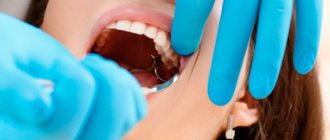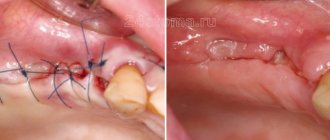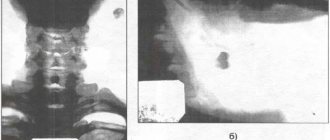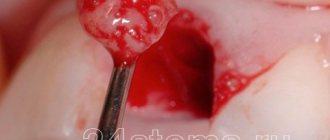The procedure itself should only be performed by an experienced surgeon and only when other treatment methods can no longer help. There are a number of reasons that can trigger the removal of an affected tooth:
- if the crown of the tooth is completely destroyed;
- when the patient is indicated for prosthetics;
- if complications arise during the eruption of a wisdom tooth;
- if filling requires perforation of the root canal.
Important! There are cases when there is every reason to remove a tooth, but the patient has contraindications to this. In such cases, most often the intervention is carried out within the walls of a hospital with subsequent monitoring of the patient’s condition.
There are a number of main contraindications to surgical tooth extraction. These include:
- previous heart attacks;
- high blood pressure;
- arrhythmia;
- blood diseases;
- mental problems or neurological diseases.
If no contraindications have been identified in a patient who needs surgical removal of the affected tooth, then he is referred to the procedure itself, which should be carried out according to the following scheme.
| Stage | Description |
| Visit doctor | Before performing the procedure, the doctor must find out whether the patient has allergic reactions to any anesthetics, cardiovascular pathologies, or whether the patient suffers from hypertension. |
| Anesthesia | After all the necessary information has been obtained, the patient is sent for anesthesia. A fairly large number of different means are currently used to remove teeth. Their duration of action is from forty minutes to three hours. |
| Preparation | Next comes preparation for the intervention itself: in order not to injure the gum during manipulation, it first peels off from the tooth bone by at least five millimeters. This procedure is carried out using a special tool. The surgeon places special forceps on the tooth, and then begins to swing the tooth itself with them in order to destroy the ligaments attached to the jaw bone. |
| Removal | The affected tooth itself is pulled out, that is, extraction. After the affected tooth has been removed, the resulting hole must be thoroughly examined. This is necessary so as not to leave tooth fragments or a cyst in the wound cavity. If the extraction of the affected tooth took place in the presence of flux, then after its removal the gums are cut in the right place and the pus is released. After this manipulation, a drainage is inserted into the wound cavity. |
| Treatment | After the procedure is completed, you need to treat the wound itself. If pus is found at the site of the lesion, then in this case the hole must be washed with an antiseptic solution, and then an anti-inflammatory agent should be placed in the wound. If the hole itself is too large after extracting the tooth, then a suture is necessary. |
| Consultation | After the procedure has been completely completed, before discharge, the doctor must instruct the patient in detail on how to care for the hole during the healing period, and also prescribe any medications if necessary. |
After the tooth is removed and before the patient goes home, the doctor inserts a special medicine into the tooth socket. It is necessary to protect the wound from various influences, as well as for faster and more proper healing. Some patients complain that the turunda with the medicine interferes greatly, but this will have to be endured.
Important! If you remove the turunda ahead of time, serious complications may develop, which will have to be dealt with not only by the dentist, but also by other doctors.
The doctor prescribes exactly the medicine that is safe for every person. True, it does not have the most pleasant taste, but a person will have to ignore this factor if he wants the wound to heal as quickly as possible.
There are exceptional cases when it is simply impossible to remove the affected tooth according to the scheme above. The reason for this may be the following factors:
- if the tooth root is crooked;
- if the bone tissue of the tooth is too fragile;
- if the crown of the affected tooth is already completely destroyed;
- if the figure eight is in a position of incomplete eruption or in a horizontal position.
If a patient who needs tooth extraction has any of these characteristics, then the intervention is performed in a different way. First, the gum is cut and peeled away from the bone. After this, the specialist drills out the desired area using a drill, which creates access to the root of the required tooth.
Important! In some cases, the partitions between the roots of the tooth are sawed, after which each root is removed one by one.
After such procedures, healing is more difficult and longer. Such an intervention may cause the patient to develop stomatitis. In many cases of such intervention, a secondary infection is attached to the affected area.
However, no matter which tooth is removed, medicine must be placed in the hole. This procedure is required.
Features of wound healing after tooth extraction
Before moving directly to hemostatic sponges, what they consist of and how to use them, you need to understand how the wound heals after removal and what can go wrong here. More on this later.
Why is there bleeding after removal?
Bleeding is a natural reaction to surgery. After all, when a tooth is removed, the smallest capillaries that penetrate the gums and ligamentous apparatus - the periodontium, which attaches the roots to the bone socket - are torn. And with difficult removal, the bleeding may be even stronger, because... The dentist makes incisions in the gums and drills into the jaw bone - the tissue is more damaged.
Bleeding is a natural reaction to surgery
Read on the topic: How long can a tooth hurt after extraction - normal and pathological.
How long does bleeding last normally?
Normally, the blood stops within 15-20 minutes (less often, within 45 minutes) and a blood clot forms in the socket. It seals the hole like a cork, preventing germs from penetrating inside. If the patient has problems that affect blood clotting, then the bleeding time is prolonged, and a clot may not form at all. And this is already fraught with inflammation of the bone socket (the pathology is called “alveolitis”). Therefore, according to indications, the dentist applies a hemostatic drug to the area of the extracted tooth.
On a note! Bleeding may appear again for a short time (and there will be quite a bit of blood) after the anesthetic wears off - if it contained adrenaline. This substance narrows the blood vessels in the intervention area, and as they expand normally, slight bleeding occurs. It goes away quickly.
Why does the bleeding not stop for a long time?
As a rule, after tooth extraction, the dentist says that you should not eat or drink for 2 hours. But few people say that you should not rinse your mouth or suck drinks out of a straw. In the first days, only oral baths are allowed, and it is better to drink in the usual way. Also, do not touch the wound with a brush. It is better to chew food on the healthy “side” of the jaw. Otherwise, there is a risk of moving or “pulling” the clot out of the hole - which will provoke new bleeding or even inflammation, which will result in long-term treatment.
The following groups of patients are also at risk:
- who has not formed a blood clot,
- with blood diseases,
- who takes blood clotting medications,
- having high blood pressure,
- women during menstruation or menopause,
- exposing themselves to physical activity immediately after removal and during the recovery process,
- if there was already inflammation at the extraction site (for example, pericoronitis above a wisdom tooth),
- during complex operations: when several teeth were removed at the same time, or manipulations were performed with increased tissue trauma.
Bleeding may occur during physical exertion after removal.
When you need urgent help
If the bleeding is profuse and does not stop for a long time, if after normalization of the condition the blood begins to ooze heavily again, this is a reason to consult a dentist. In a situation where the patient, in the presence of continuous bleeding, feels weakness, apathy, if the temperature has risen sharply (above 39 degrees Celsius), it is better to call an ambulance or go to the hospital on your own.
What should the patient do after the procedure?
After the procedure has been completed, the specialist must carefully explain to the patient his next steps, as well as the rules for caring for the wound during the healing period.
- The turunda or cotton wool that was left by the surgeon in the hole does not need to be removed by yourself. If the tampon placed by the doctor falls out ahead of schedule, the patient must return to the specialist to install a new turunda. If this is not done, an infection may enter the wound cavity.
- If after the procedure the cheek is very swollen, you can apply ice or a cold compress to it. After this procedure, it is forbidden to heat the affected area and apply hot compresses.
- You can eat food after tooth extraction only two hours after the procedure. It is recommended to eat only liquid and light foods that do not contain solid pieces.
- A blood clot forms in the hole where the tooth was pulled out. It is prohibited to remove it or touch it. The first time after the procedure, you must brush your teeth with caution and do not use any rinses.
- For 7 days after tooth extraction, it is prohibited to carry out other interventions in the oral cavity.
- During the healing period, it is not recommended to overheat, for example, take a steam bath, and also exercise with caution. It is also strongly recommended to stop drinking alcoholic beverages and smoking cigarettes for two days after the procedure.
- After tooth extraction, pain often occurs at the extraction site. In this case, quite often not only the hole, but the whole head as a whole can hurt. Also, the patient may experience pain while eating, regardless of which side of the teeth he chews on. Experts recommend coping with these problems with the help of painkillers, such as Pentalgin or Tempalgin. In this case, it is advisable to take the drug in combination with Suprastin.
Despite the fact that there is medicine in the hole, a person may still feel pain and some burning. Such unpleasant sensations will have to be ignored.
Important! If the sensations intensify, it is recommended to consult a doctor again so that he can examine the wound and, if necessary, take action.
What is a hemostatic sponge
Now let's move on to why a hemostatic sponge is placed in the hole left after tooth extraction? Let's first understand the terminology. “Hemo” means “blood” and “stasis” means stopping. Those. a hemostatic sponge is needed to stop bleeding. In simple terms, this is a kind of replacement for a blood clot. The hemostatic sponge in the tooth socket not only seals the open cavity, but also has a hemostatic effect. Firstly, it puts pressure on small vessels, stopping bleeding. Secondly, it absorbs excess blood, increasing several times. The bleeding stops within 2-3 minutes.
On a note! By the way, local hemostatic agents are used not only in dentistry, but also in other areas of medicine - for example, hemostatic bandages successfully replace tourniquets that are applied for bleeding.
About the medicine
The medicine that is placed in the hole can be applied to a piece of gauze, which is subsequently inserted into the hole. In this case, after a certain amount of time indicated by the doctor, it needs to be taken out. This can be done either independently or during your next visit to the dentist. If this is not done in time, the process of putrefaction may begin, which will greatly complicate the situation. It is also not recommended to take out the gauze ahead of time, since food particles can get into the hole and the tongue can touch it, which will interrupt the healing process and also cause complications.
There is another way to install the medicine - in a hemostatic sponge. It already contains a medicine that helps disinfect the socket cavity and helps stop bleeding. You cannot take this sponge out - it will dissolve on its own. Most often this happens within 1-2 days, but in some cases the sponge may remain in the hole for 5-6 days. There is no need to be afraid of this. As a last resort, you can consult a doctor who will examine the wound and determine whether healing is proceeding normally.
Often the medicine in the sponge is very bitter, and this causes severe discomfort to the person. Unfortunately, nothing can be done about this, since getting rid of the sponge ahead of time is strictly contraindicated. To eliminate bitterness, you can drink sweet tea or juice.
Remember! No circumstances can influence the ability to remove the medicine from the hole ahead of time. After 3-4 days, the surface of the hole will heal, and you will no longer have to experience discomfort.
People often wonder what kind of medicine is used for these purposes. Sometimes the gauze that is placed in the hole is treated with iodine - this will both disinfect the wound and prevent bleeding. The hemostatic sponge is already treated with a special substance consisting of boric acid, collagen and nitrofural, which helps stop the bleeding and protect the hole from various influences. But most often dentists use Alvozhil.
No other means are used for inserting into the hole.
Appearance and release form
The hemostatic sponge looks like a cube or plate, which looks like a small sponge or a piece of yellow or white foam rubber. Although in fact it consists mainly of natural collagen with various medicinal additives. The plate is quite soft and easy to cut, which allows the dentist to cut the desired size according to the shape of the hole.
The plate is quite soft and easy to cut
Manufacturers produce both small (1x1 centimeter) and large sponges (10x10 cm). The plates are tightly sealed in transparent bags, and the cubes are sealed in dark, opaque bottles. Hemostatic powders and gels are also produced. Absolutely all collagen hemostatics dissolve on their own in the wound over time.
Types of hemostatic sponges
According to the manufacturing method, hemostatic sponges for teeth are of the following types:
- from donor blood plasma - amben,
- from bones/tendons/blood of cattle - collagen and gelatin.
You need to understand that a hemostatic agent not only stops bleeding (due to aminocaproic acid, for example) and stimulates the formation of a blood clot, but also has an antiseptic effect. It can also accelerate regeneration and relieve inflammation. It all depends on the active components that make up the hemostatic sponge. The drug can be impregnated with the following substances:
- antiseptics: chlorhexidine, furatsilin, silver suspension, boric acid, iodoform,
- local anesthetics: for example, lidocaine,
- preparations for bone regeneration: calcium phosphate,
- antibiotics: metronidazole, chloramphenicol, neomycin, gentamicin, etc.,
- natural substances: propolis, eugenol, etc.
Hemostatic sponges for teeth come in different types
What is she?
So, a hemostatic sponge is an effective hemostatic agent, widely used in various medical fields, in particular, by dentists when removing teeth. The sponge has pronounced antiseptic and sorbing properties, and therefore not only stops bleeding, but also protects the wound from bacteria. In addition, thanks to the described remedy, damaged sockets heal faster.
Main types of hemostatic sponges
So, the described remedy is intended not only to stop bleeding, but also to prevent the occurrence of inflammatory processes if a complex surgical intervention was performed (for example, a wisdom tooth was removed). In standard cases of extraction, bleeding is stopped with the help of a collagen sponge that stops the bleeding.
After surgery, if there is a risk of inflammation in the tooth socket, dentists often recommend using “Alvostaz” - this is a special alveolar compress made in the form of a sponge. "Alvostaz" has an antiseptic and hemostatic effect, in addition, the drug is often used for the prevention/therapy of alveolitis.
About release forms
So, what is a hemostatic sponge? Essentially, it is a yellowish pressed powder that has a faint aroma of acetic acid. These sponges are sold in the form of small rectangular elastic plates (their sizes can be 5x5 cm and 9x9 cm) with a porous dry structure. During production, sponges are placed in PET bags, which are tightly closed, and then placed individually in cardboard packaging.
These sponges - just like regular sponges - perfectly absorb liquid, swelling at the same time. Sponges do not dissolve in cold water, as well as in substances of organic origin, but can partially dissolve in water whose temperature is more than 75 degrees. To make pressed plates, a collagen solution is used - it is obtained from the tendons/skin of cattle. There are also additional components - boric acid and nitrofural.
The above-mentioned “Alvostaz” is considered one of the most effective remedies. The product is sold in the form of small (dimensions - 1x1 cm) hemostatic sponges soaked in a special solution, packaged in plastic jars of 30 pieces. "Alvostaz" is produced in three versions; it contains propolis, eugenol, tricalcium phosphate, iodoform, lidocaine and thymol.
Effect of hemostatic sponges
The product described in the article is used locally (it is used to pack wounds) and has a wide spectrum of action, namely:
- stops bleeding;
- accelerates wound healing;
- protects the hole from bacterial infection;
- prevents swelling of gum tissue;
- stops the focus of the inflammatory process;
- eliminates painful sensations.
Note! The hemostatic sponge is effective for several hours after tooth extraction. After a certain time (indicated by the manufacturer), the sponge placed in the hole dissolves completely.
Manufacturers of hemostatic sponges
Popular manufacturers of hemostatic agents used by dentists in our country are domestic companies. Let's consider them further:
- Alvostaz compress from Omega-Dent: available in the form of cubes, flagella, powders and solutions. The compresses are numbered - “1” with iodoform, “2” with metronidazole and chlorhexidine, “3” with neomycin and chloramphenicol,
- "Gemasept" with gentamicin from the Russian Research Institute of Hematology and Transfusiology of the Federal Medical and Biological Agency",
- “Collagen hemostatic sponge” with silver and boric acid from “Zelenaya Dubrava”,
- “Hemostatic sponge” with furatsilin and boric acid from “Belkozin”.
Indications for use
A hemostatic sponge can be useful after tooth extraction, especially wisdom teeth. Because the “eights” often do not erupt completely, and the dentist has to perform a mini-operation to get to them and remove them along with the roots. When a tooth is removed, a hemostatic agent is placed 3-4 months before implantation to completely eliminate the possibility of complications and problems with the formation of new bone in the socket.
Also, hemostatic sponges or powders are used during operations on the gums1 - plastic surgery, curettage of gum pockets (removal of deep “deposits” of tartar), and when cutting off dead areas of the jaw bone due to osteomyelitis. In the latter case, bone blocks and materials for regeneration of bone substance are additionally planted. In general, the doctor always assesses the patient’s condition in advance - asks about diseases and other conditions, and about the medications taken. If there is a risk of bleeding or poor regeneration, then rest assured, a hemostatic sponge will definitely be placed in the hole.
These sponges are used for bone augmentation
It is important to know! A few days after tooth extraction, it may be necessary to apply a hemostatic sponge if the dentist sees a tendency to worsen. For example, a clot has fallen out or the gums/bone have become inflamed.
Taking antibiotics after the procedure
Dentists quite often resort to antibiotics in the postoperative period, especially after tooth extraction. But not every patient who has undergone tooth extraction requires antibiotics. They are prescribed only in the following cases:
- if the patient experiences inflammatory processes in the gum area;
- if the patient is elderly;
- if complications arise during the operation or features of the anatomy of the teeth are revealed, which contributes to more extensive trauma;
- if the patient has a reduced immune system or suffers from any blood diseases.
This list is not all the reasons for prescribing antibiotics in the postoperative period, because each individual case has its own characteristics. An experienced dentist will be able to easily determine which patient needs to take medications after tooth extraction. The doctor must determine the duration of administration and dose individually for each case. Most often, the course of taking the drug after tooth extraction lasts from five to seven days. In rare complicated cases, treatment can last up to fifteen days. It is simply impossible to determine the average dose of antibiotics that is needed, since each individual drug has its own individual characteristics.
Important! It is strongly recommended not to take antibiotics unless prescribed by a doctor.
In addition to antibiotics, your doctor may also prescribe medications to normalize the microflora after taking antibiotics. The most commonly prescribed drug is Linex, but sometimes other drugs from the group of probiotics are also prescribed.
How to use the drug correctly
How to use the sponge? The hemostatic sponge is placed into the socket of the extracted tooth only by the dentist. Home use is not recommended due to the risk of infection deep into the tissues. The application procedure is given step by step below:
- tooth extraction or treatment of the hole a few days after removal: in the latter case, purulent masses are removed, irrigation is carried out with an antiseptic,
- a piece of the hemostatic plate is cut off with sterile scissors or a hemostatic cube is taken with tweezers,
- the drug is placed in the hole and pressed with a flat instrument: if the hemostatic agent is pre-saturated with thrombin, the hemostatic effect is enhanced,
- if necessary, an additional piece of hemostatic is applied,
- if necessary, a small tampon is placed on top of the hole (it will be removed the next day),
- suturing the gums - a seam in the shape of the letter “P”: also, if necessary, in most cases you can do without stitches.
A piece of the hemostatic plate is cut with sterile scissors.
Auxiliary medications for tooth extraction
If, after the tooth is removed, any complications begin at the intervention site, then modern pharmaceuticals can cope with them. With the help of various medications, the patient can not only eliminate the resulting secondary complications, but also strengthen his immunity as a whole. Quite often, specialists, to ensure against possible complications, in particular, various inflammations and suppurations, prescribe antibacterial drugs in the postoperative period. At the same time, the patient also needs to strengthen the immune system, which will help the wound heal faster. To do this, doctors prescribe vitamin complexes to the patient. Thus, in addition to the medicine placed in the hole and affecting its healing, the patient is recommended to take other drugs to speed up the process.
If during the procedure the patient was identified with any peculiarities or complications and tooth extraction was not without additional trauma, then a number of medications are prescribed in the postoperative period, since in this case there are additional risks of complications. The main thing is that the patient treats the postoperative period responsibly and does not neglect the doctor’s advice and the medications prescribed to him.
Important! According to statistics, every third patient who has had a tooth removed needs to take antibiotics.
Is it necessary to remove the hemostatic agent?
Patients often wonder what to do with a hemostatic sponge after it has been placed in the socket of an extracted tooth? How long should I keep it on, and will it dissolve on its own? The rules of conduct are as follows: carefully but thoroughly observe oral hygiene, and also take medications prescribed by the dentist. There is no need to specially remove the hemostatic agent - after all, it consists of components that will completely dissolve during wound healing. And instead of a hemostatic agent, its own tissues form in the hole.
“When my wisdom tooth was removed, they stuffed it into the wound like a piece of foam rubber. I then saw the houses through the seams. I was also surprised - what is it? And at the next appointment, my dentist told me that this is a special sponge that absorbs blood and protects against infection. And when it resolved, I didn’t even notice)) It probably completely disappeared in a couple of weeks.”
Ekaterina R., review from irecommend.com
What painkillers can be taken in the postoperative period?
Most often, when local anesthesia wears off after a tooth extraction procedure, the patient feels pain in the area of intervention. The best way to eliminate pain is to take NSAIDs. This group of drugs is the most effective in eliminating toothache.
- The drugs "Nurofen" or "Ibuprofen" cope well with pain after surgery. It is necessary to take the drug 500-800 mg three to four times a day, depending on the intensity of the pain.
- "Ketorol" is one of the most effective and powerful drugs from the NSAID group, which can eliminate pain after the procedure in a fairly short time. It is also used two tablets three to four times throughout the day.
Contraindications and side effects
The only contraindication to the use of a hemostatic sponge after tooth extraction is an individual allergy to any of the components of the drug. In particular, for antibiotics that are used to impregnate the hemostatic agent. Therefore, be sure to tell your dentist if you are allergic and to what medications. Hemostatic agents should also be used with extreme caution in children.
There are no side effects, because There are no toxic substances or components that affect perception in hemostatics. But if itching, inflammation, or swelling appears, feel free to contact your dentist. These manifestations can be caused either by a newly manifested allergy or by incipient complications - if, for example, the treatment was carried out poorly or the patient did not follow the doctor’s instructions.
1Skulean A. Periodontal regeneration, 2012.
Contraindications
The main contraindication to the use of collagen sponges to stop bleeding is hypersensitivity to any components used in their manufacture. In particular, this is intolerance to nitrofuran drugs. With increased sensitivity to them, severe allergic skin reactions are observed, accompanied by severe itching.
Collagen sponges should not be used to stop arterial bleeding. In this case, a tourniquet must be applied and the person must be urgently transported to a medical facility to provide qualified surgical care.
Contraindications to the use of collagen-based hemostatic sponges are skin lesions caused by pyogenic bacteria. In this case, the wound must be periodically treated with antiseptic agents to remove its purulent contents.











